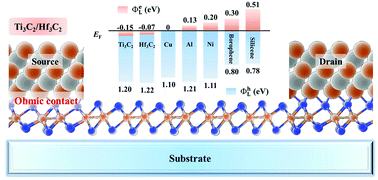Selecting electrode materials for monolayer ReS2 with an Ohmic contact†
Abstract
Monolayer rhenium disulfide (ReS2), an emerging two-dimensional (2D) semiconductor with a direct band gap and high carrier mobility, holds great promise for channel materials in field effect transistors (FETs). The contact between the channel and the electrode has crucial impacts on the performance of realistic ReS2-based FETs. Using first-principles calculations and quantum transport simulations, here, we systematically explore the electrical contact properties of ReS2 FETs with a series of potential electrode materials, including silicene, borophene, Al, Ni and Cu metals, Ti3C2 and Hf3C2 MXenes. These electrode materials exhibit different coupling strengths with the ReS2 sheet, which governs the efficiency of carrier injection. All the considered systems form an n-type Schottky contact. They show a strong Fermi-level pinning effect due to either metallization of the ReS2 monolayer or formation of interfacial dipoles for the strongly and weakly coupled systems, respectively. Especially, an Ohmic contact can be achieved by using Ti3C2 or Hf3C2 MXene electrodes with a strong interfacial interaction and a relatively smaller work function. These theoretical results provide vital insights into the contact properties and electronic transport properties of monolayer ReS2, and they will promote the experimental fabrication of high-performance ReS2-based devices.



 Please wait while we load your content...
Please wait while we load your content...